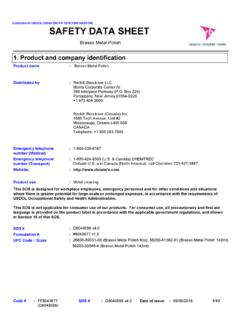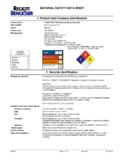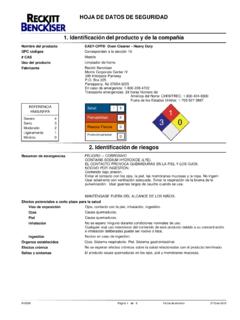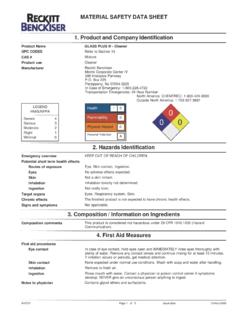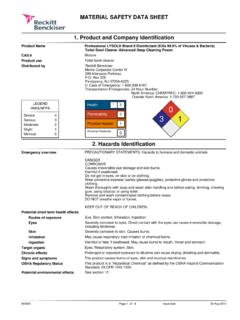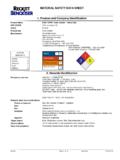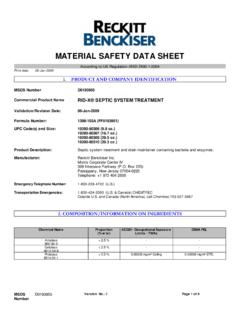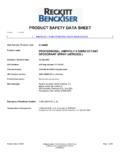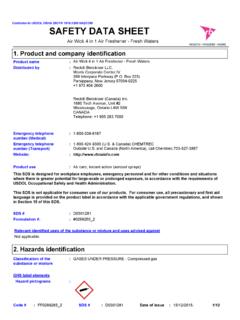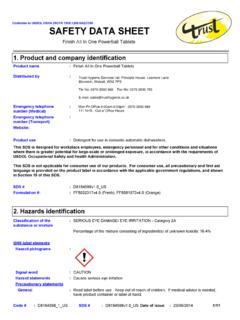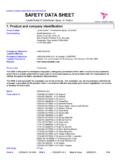Transcription of Conforms to USDOL OSHA 29CFR 1910.1200 HAZCOM …
1 Old English Scratch Cover - Light WoodPolishes, wax/cream (floor, furniture, shoes)SAFETY DATA SHEETP roduct nameDistributed byProduct use1. Product and company identification::D0046177:SDS #Formulation #::#890559_2 Old English Scratch Cover - Light Wood:Website: telephone number (Medical)Emergency telephone number (Transport):1-800-338-61671-800-424-9300 ( & Canada) CHEMTREC Outside and Canada (North America), call Chemtrec:703-527-3887:This SDS is designed for workplace employees, emergency personnel and for other conditions and situations where there is greater potential for large-scale or prolonged exposure, in accordance with the requirements of USDOL Occupational Safety and Health SDS is not applicable for consumer use of our products. For consumer use, all precautionary and first aid language is provided on the product label in accordance with the applicable government regulations, and shown in Section 15 of this Benckiser Corporate Center IV 399 Interpace Parkway ( Box 225)Parsippany, New Jersey 07054-0225 +1 973 404 2600 Conforms to USDOL osha 29 CFR HAZCOM2.
2 Hazards identificationClassification of the substance or mixtureFLAMMABLE LIQUIDS - Category 4:Signal word:WarningHazard statements:Combustible pictograms:GHS label elementsPercentage of the mixture consisting of ingredient(s) of unknown toxicity: :Wear protective gloves. Wear eye or face protection. Keep away from flames and hot surfaces. - No :Not :Store in a well-ventilated place. Keep cool.:Read label before use. Keep out of reach of children. If medical advice is needed,have product container or label at statements1/1013/08 of issue:SDS #FF890559_2:Code #D0046177:D0046177 Conforms to USDOL osha 29 CFR HAZCOM2. Hazards identificationSupplemental label elements:None not otherwise classified:None :Dispose of contents and container in accordance with all local, regional, national and international Composition/information on ingredientsMixture:Substance/mixtureTher e are no ingredients present which, within the current knowledge of the supplier and in the concentrations applicable, are classified as hazardous to health or the environment and hence require reporting in this First aid measuresWash out mouth with water.
3 Remove dentures if any. Move to fresh air. If material has been swallowed and the exposed person is conscious, give small quantities of water to drink. Stop if the exposed person feels sick as vomiting may be dangerous. Do not induce vomiting unless directed to do so by medical personnel. If vomiting occurs, the head should be kept low so that vomit does not enter the lungs. Get medical attention if adverse health effects persist or are severe. Never give anything by mouth to an unconscious person. If unconscious, place in recovery position and get medical attention immediately. Maintain an open flush eyes with plenty of water, occasionally lifting the upper and lower eyelids. Check for and remove any contact lenses. Continue to rinse for at least 10 minutes. Get medical attention if irritation contaminated skin with plenty of water.
4 Remove contaminated clothing and shoes. Get medical attention if symptoms victim to fresh air and keep at rest in a position comfortable for breathing. If not breathing, if breathing is irregular or if respiratory arrest occurs, provide artificial respiration or oxygen by trained personnel. It may be dangerous to the person providing aid to give mouth-to-mouth resuscitation. Get medical attention if adverse health effects persist or are severe. If unconscious, place in recovery position and get medical attention immediately. Maintain an open contactSkin contactInhalationIngestion::::Notes to physician:Treat of necessary first aid measuresSpecific treatments:No specific important symptoms/effects, acute and delayedInhalation:No known significant effects or critical known significant effects or critical hazards.
5 :IngestionSkin contact:No known significant effects or critical known significant effects or critical hazards.:Eye contactOver-exposure signs/symptomsSkin contactIngestionInhalationNo specific specific specific data.:::Eye contact:No specific acute health effectsIndication of immediate medical attention and special treatment needed, if necessary2/1013/08 of issue:SDS #FF890559_2:Code #D0046177:D0046177 Conforms to USDOL osha 29 CFR HAZCOM4. First aid measuresProtection of first-aiders:No action shall be taken involving any personal risk or without suitable training. It may be dangerous to the person providing aid to give mouth-to-mouth toxicological information (Section 11)5. Fire-fighting measuresPromptly isolate the scene by removing all persons from the vicinity of the incident if there is a fire. No action shall be taken involving any personal risk or without suitable training.
6 Move containers from fire area if this can be done without risk. Use water spray to keep fire-exposed containers thermal decomposition productsSpecific hazards arising from the chemicalNo specific liquid. In a fire or if heated, a pressure increase will occur and the container may burst, with the risk of a subsequent explosion. Runoff to sewer may create fire or explosion should wear appropriate protective equipment and self-contained breathing apparatus (SCBA) with a full face-piece operated in positive pressure protective equipment for fire-fightersUse dry chemical, CO , water spray (fog) or media:::Do not use water extinguishing media:Unsuitable extinguishing media:Special protective actions for fire-fighters:6. Accidental release measuresEnvironmental precautionsPersonal precautions, protective equipment and emergency procedures::No action shall be taken involving any personal risk or without suitable surrounding areas.
7 Keep unnecessary and unprotected personnel from entering. Do not touch or walk through spilled material. Shut off all ignition flares, smoking or flames in hazard area. Avoid breathing vapor or mist. Provide adequate ventilation. Wear appropriate respirator when ventilation is inadequate. Put on appropriate personal protective dispersal of spilled material and runoff and contact with soil, waterways, drains and sewers. Inform the relevant authorities if the product has caused environmental pollution (sewers, waterways, soil or air).Stop leak if without risk. Move containers from spill area. Use spark-proof tools and explosion-proof equipment. Dilute with water and mop up if water-soluble. Alternatively,or if water-insoluble, absorb with an inert dry material and place in an appropriate waste disposal container.
8 Dispose of via a licensed waste disposal spill:Methods and materials for containment and cleaning upFor non-emergency personnelFor emergency responders:If specialised clothing is required to deal with the spillage, take note of any information in Section 8 on suitable and unsuitable materials. See also the information in "For non-emergency personnel".3/1013/08 of issue:SDS #FF890559_2:Code #D0046177:D0046177 Conforms to USDOL osha 29 CFR HAZCOM6. Accidental release measuresStop leak if without risk. Move containers from spill area. Use spark-proof tools and explosion-proof equipment. Approach release from upwind. Prevent entry into sewers,water courses, basements or confined areas. Wash spillages into an effluent treatment plant or proceed as follows. Contain and collect spillage with non-combustible,absorbent material sand, earth, vermiculite or diatomaceous earth and place in container for disposal according to local regulations (see Section 13).
9 Dispose of via a licensed waste disposal contractor. Contaminated absorbent material may pose the same hazard as the spilled product. Note: see Section 1 for emergency contact information and Section 13 for waste spill:7. Handling and storageConditions for safe storage,including any incompatibilitiesStore in accordance with local regulations. Store in a segregated and approved in original container protected from direct sunlight in a dry, cool and well-ventilated area, away from incompatible materials (see Section 10) and food and drink. Eliminate all ignition sources. Separate from oxidizing materials. Keep container tightly closed and sealed until ready for use. Containers that have been opened must be carefully resealed and kept upright to prevent leakage. Do not store in unlabeled appropriate containment to avoid environmental contamination.
10 :Protective measuresPut on appropriate personal protective equipment (see Section 8). Do not ingest. Avoid contact with eyes, skin and clothing. Avoid breathing vapor or mist. Use only with adequate ventilation. Wear appropriate respirator when ventilation is inadequate. Do not enter storage areas and confined spaces unless adequately ventilated. Keep in the original container or an approved alternative made from a compatible material, kept tightly closed when not in use. Store and use away from heat, sparks, open flame or any other ignition source. Use explosion-proof electrical (ventilating, lighting and material handling) equipment. Use only non-sparking tools. Empty containers retain product residue and can be hazardous. Do not reuse container.:Precautions for safe handlingNot Exposure controls/personal protectionEnvironmental exposure controls:Emissions from ventilation or work process equipment should be checked to ensure they comply with the requirements of environmental protection legislation.
